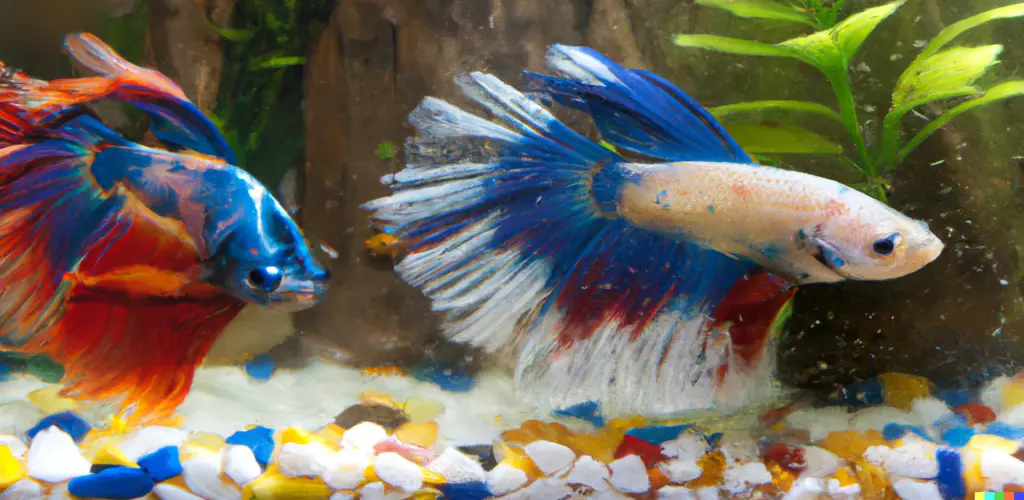Betta fish, or Siamese fighting fish, are popular freshwater fish often kept as pets. They are known for their vibrant colors and unique personalities, making them a favorite among fish enthusiasts. However, one common issue that many betta fish owners face is a slimy tank. In this article, we will discuss the reasons why is my betta fish tank slimy and how to prevent this issue.
What is a Slimy Tank?
Before we dive into the reasons behind a slimy tank, let’s first define what we mean by “slimy.” A slimy tank is a tank that appears to have a thin layer of slime coating the surfaces. You can find slime on the glass, decorations, and fish. The slime is often clear or white in color and can have a sticky or slimy texture.
Reasons for Why is my Betta Fish Tank Slimy

Overfeeding
One of the most common reasons for a slimy tank is overfeeding. Betta fish have small stomachs and can only eat a small amount of food at once. When they are overfed, the excess food can break down and produce waste, which can lead to an increase in bacteria and algae growth. This, in turn, can cause a slimy film to form on the tank surfaces. Feeding your betta fish a small amount of food once or twice a day is essential to prevent overfeeding. After a few minutes, you should also remove any uneaten food from the tank.
Poor Water Quality
Another reason for a slimy tank is poor water quality. Betta fish require clean water to thrive, and if the water quality is poor, it can increase bacteria and algae growth. This can cause a slimy film to form on the tank surfaces.
To prevent poor water quality, you should regularly change the water in your betta fish tank. A good rule of thumb is to change 25% of the water once a week. It would be best if you also used a water conditioner to remove any chlorine or chloramine from the tap water.
Overcrowding
Betta fish require a certain amount of space to swim and thrive. If the tank is overcrowded, it can increase waste and bacteria, which can cause a slimy film to form on the tank surfaces.
To prevent overcrowding, you should ensure that your betta fish has enough space to swim and that the tank is open. A good rule of thumb is to provide at least 2.5 gallons of water per betta fish.
Lack of Filtration
A lack of filtration can also lead to a slimy tank. Filters help to remove waste and bacteria from the water, preventing the growth of algae and bacteria that can cause a slimy film to form on the tank surfaces.
To prevent a lack of filtration, you should ensure that your betta fish tank has a suitable filter. The filter should be sized appropriately for the tank and cleaned or replaced regularly.
Is Slime Dangerous for a Betta Tank
When left unchecked, the slime can accumulate on the tank surfaces, decorations, and substrate, creating a breeding ground for harmful bacteria and parasites. These microorganisms can cause various health issues for your betta fish, including infections, diseases, and stress. In addition, the slime can clog the gills and fins of your fish, making it difficult for them to breathe and swim. This can lead to a decreased lifespan and overall quality of life for your betta fish. Therefore, it’s important to take prompt action to remove slime from your betta fish tank and maintain proper care and maintenance to prevent its formation in the future.
Why does my Betta Tank get Slimy: Prevention
Now that we’ve discussed the reasons behind a slimy tank let’s discuss how to prevent it. Here are a few tips:
- Feed your betta fish a small amount of food once or twice a day, and remove any uneaten food from the tank after a few minutes.
- Change 25% of the water in your betta fish tank once a week, and use a water conditioner to remove any chlorine or chloramine from the tap water.
- Provide at least 2.5 gallons of water per betta fish and ensure the tank is not overcrowded.
- Use a suitable filter for your betta fish tank and clean or replace it regularly.
How to Remove Slime from a Betta Fish Tank

If you notice a slimy film coating the surfaces of your betta fish tank, it’s essential to take action to remove it promptly. Not only can the slime be unsightly, but it can also harm your fish’s health if left unchecked. Here are some tips and tricks to help you remove slime from your betta fish tank and restore it to a healthy state.
Step 1: Perform a Partial Water Change
The first step in removing slime from your betta fish tank is to perform a partial water change. This will help to remove any excess waste and bacteria that may be contributing to the slime. Use a siphon or a gravel vacuum to remove about 25% of the water from the tank, careful not to disturb the gravel or decorations. Replace the old water with fresh, conditioned water that’s been allowed to reach room temperature.
Step 2: Remove Excess Waste and Food
After performing the water change, take some time to remove any excess waste or uneaten food from the tank. Use a net or gravel vacuum to remove debris from the substrate, and use a clean, soft-bristled brush to remove any slime from the decorations or tank surfaces gently.
Step 3: Clean the Tank
To clean the tank:
- Use an algae scraper or a sponge to remove any remaining slime from the tank surfaces. You can also use a solution of white vinegar and water to help break down the slime.
- Mix one part white vinegar with three parts water, and use a clean cloth or sponge to apply the solution to the affected areas.
- Rinse the tank thoroughly with fresh water to remove any remaining vinegar residue.
Step 4: Maintain Proper Care and Maintenance
It’s crucial to maintain proper care and maintenance of your betta fish tank to prevent slime formation in the future. Feed your fish the recommended amount of food, and remove any uneaten food from the tank after a few minutes. Perform regular water changes, and use a water conditioner to neutralize any chlorine or chloramine in the tap water. Provide your betta fish with plenty of swimming space and a suitable filter to help keep the water clean and clear.
Conclusion
In conclusion, a slimy betta fish tank can be unsightly and harmful to your fish’s health. By following the tips and tricks outlined above, you can remove the slime from your tank and prevent its formation in the future. Remember to maintain proper care and maintenance of your betta fish tank to provide your fish with a clean and healthy environment to thrive.
Frequently Asked Questions:
Q: Why is my Betta Fish Tank Slimy?
A: There are several reasons why a betta fish tank may become slimy. One common cause is overfeeding, leading to excess waste and uneaten food in the tank. Poor water quality can also contribute to slime formation, as can overcrowding and a lack of filtration.
Q: Can Slime harm my Betta Fish?
A: Yes, slime can harm your betta fish if left unchecked. It can clog the gills and fins, making breathing and swimming difficult for your fish. Additionally, the slime can create a breeding ground for harmful bacteria and parasites that can make your fish sick.
Q: How can I Prevent my Betta Fish Tank from becoming Slimy?
A: To prevent slime from forming in your betta fish tank, it’s important to maintain proper care and maintenance. This includes regular water changes, feeding your fish the recommended amount of food, and using a suitable filter to keep the water clean and clear. You should also avoid overcrowding the tank and ensure your betta fish has ample swimming space.
Q: How often do you change Betta Fish Tank Water?
A: It’s recommended to perform a partial water change every week or every other week, depending on the size of your tank and the number of fish you have. You should also clean the tank surfaces and decorations to remove excess waste or slime. Regular maintenance and cleaning can help prevent slime formation and keep your betta fish healthy and happy.




Pingback: How Long Can A Betta Fish Live Without A Heater? Answered